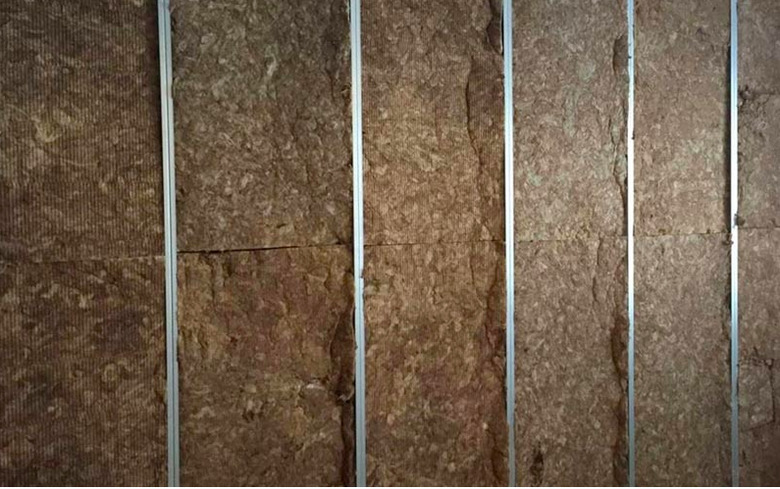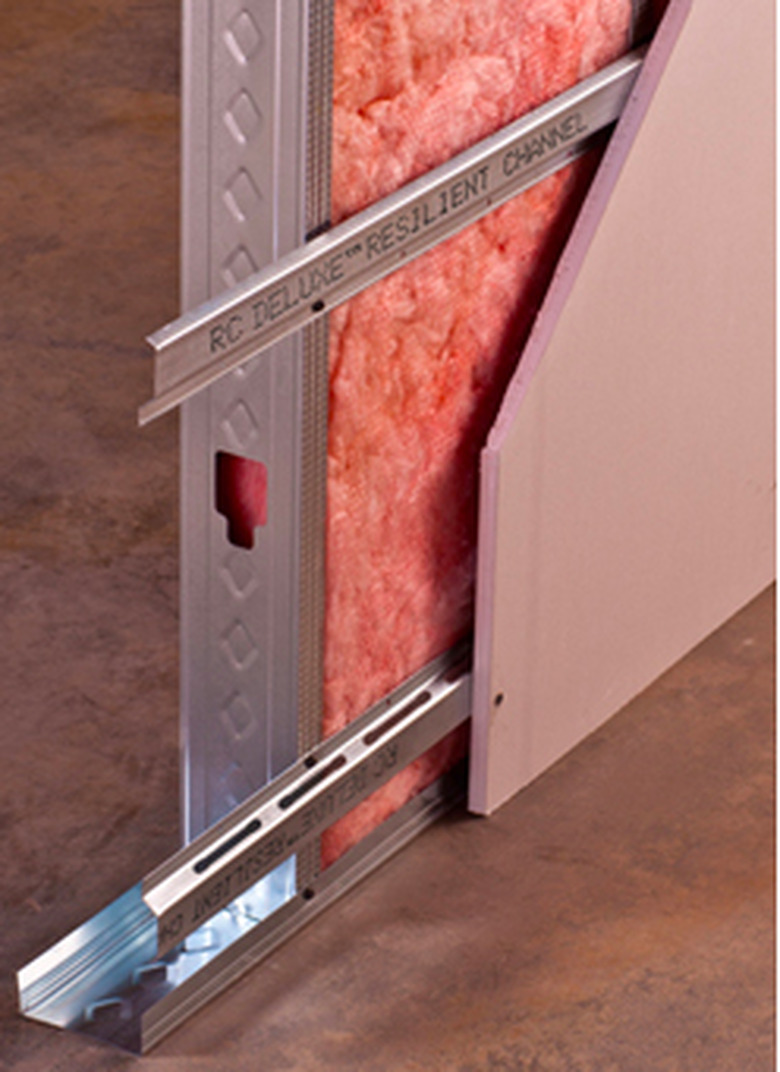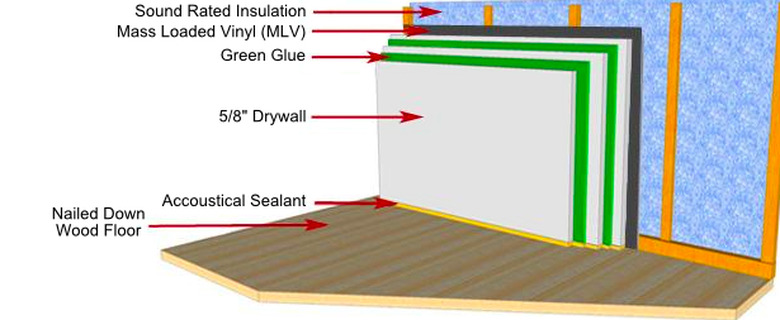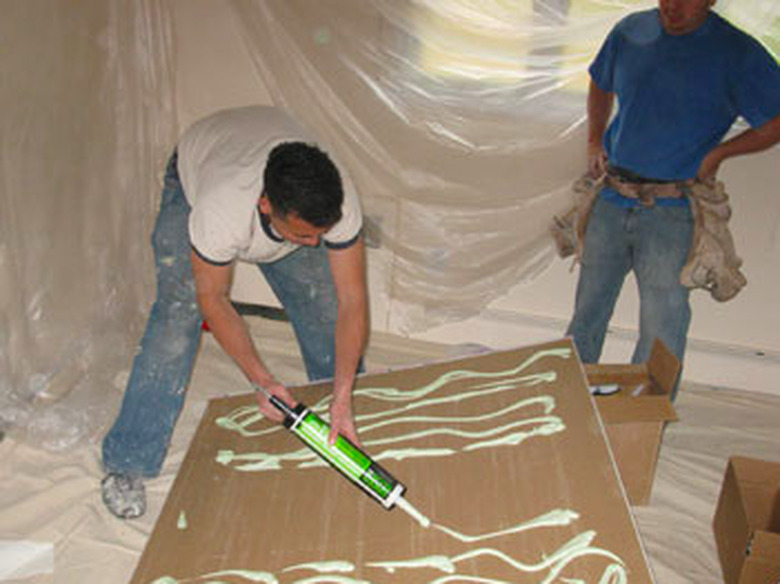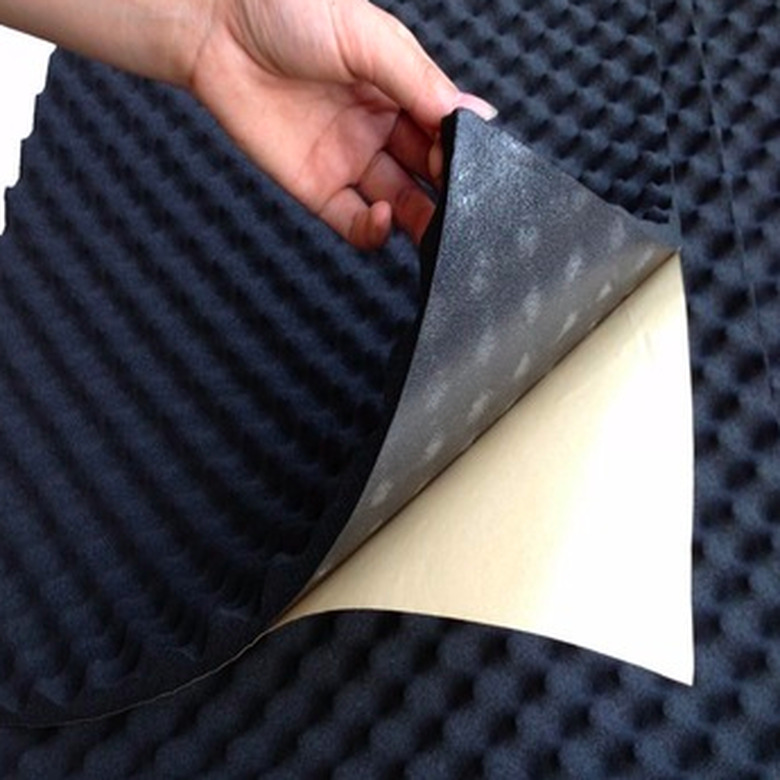Techniques For Soundproofing Walls
Unless a building or a room in a building is being built specifically to be quiet, the question of soundproofing usually doesn't arise until occupants complain. It's easier to soundproof during construction than to do it after the fact, but products do exist that allow you to add effective soundproofing without removing drywall. The optimum soundproofing strategy depends on the level of noise abatement you want to achieve, and that depends in part on the frequency of the sound source. Soundproofing materials that filter out loud conversations may be ineffective against traffic noises or drums.
If all you want is to block the sound of your neighbors' voices so you can get a good night's sleep, you may be able to do it by installing an extra layer of special drywall or hanging soundproofing drapes. However, if your goal is to create a cocoon to retreat from a noisy world—or create a recording studio—you probably need to remove the drywall and add materials to the framing.
Sound Transmission Ratings
Sound Transmission Ratings
The effectiveness of a soundproofing material is quantified by its STC (Sound Transmission Class) rating. Manufacturers determine this in a test situation in which a signal of known intensity is passed from one room through a barrier of specified thickness to another room, where the sound intensity is measured in several different frequencies. The measurements produce a curve, because transmission loss varies with the frequency of the sound. The STC rating of a particular barrier is determined by comparing the curve to standard STC reference curves.
While the STC rating of an insulating material does give an idea of its soundproofing ability, it doesn't tell the whole story. The STC number only considers frequencies down to 125 Hz, and many sounds that cause complaints, such as traffic noises and the bass sounds coming from powerful speakers, vibrate at frequencies lower than that. Some materials are better at blocking low-frequency noises than others, even though they may have lower STD ratings. In the end, the nature of the sound you want to block is the main determinant of the insulating material you should use.
Four Strategies for Sound Reduction
Four Strategies for Sound Reduction
The physics of sound transmission through a wall is a little complicated, but basically, there are four methods for reducing it and creating a quieter environment in a room.
Increase mass. Sound travels more easily through a light material than it does through a dense one. Heavy materials, such as glass, concrete, and metal, all impede sound transmission. Sometimes adding an extra layer of drywall to a wall is all you need to do to reduce noise to a comfortable level.
Absorb the vibrations. A layer of sound absorbing material will absorb sound in a wall in the same way that a pillow absorbs the sound of a frustrated scream during a therapeutic session. Fiberglass insulation provides some degree of sound absorption, but the best in-wall sound absorber is rock wool insulation, which is dense while still being porous enough to absorb vibrations.
Dampen the vibrations. Super-dense materials, such as Mass Loaded Vinyl (MLV), resist vibration, so when sound waves pass through them, the amplitude of the waves decreases. These materials are effective for covering noisy pipes and ducts inside the wall. MLV comes in rolls, and you can install it behind drywall.
Decouple the wall covering from the framing. Sound passes through a wall because the wall materials transmit the vibrations. The sound will not have a direct pathway through the wall if you separate the wallboard from the framing. One method for accomplishing this is to attach resilient metal channels to the studs, which allows drywall to "float" and reduces its ability to transmit sound waves. Or, you can build the wall with staggered rows of studs arranged in such a way that the wall coverings on either side of the wall are attached to different studs.
Soundproofing During Remodeling
Soundproofing During Remodeling
You have more soundproofing options if you're working with uncovered walls or building walls from scratch. You can combine a sound-absorbing method, such as installing rock wool insulation, with a decoupling method like resilient channel or staggered studs. If you have access to noisy ducts or pipes, you can cover them with a sound-dampening material, such as MLV, before you install the insulation. When you cover the walls, install a double layer of drywall, or install soundproofing drywall, which has a heavy core made of metal or some other material to add extra mass. In short, you can take advantage of all four soundproofing methods to get the maximum sound reduction.
Post-Construction Soundproofing
Post-Construction Soundproofing
Many sound problems arise only after construction is finished. Noisy neighbors may move in next door, or a new housing project may bring an increase in noise in the neighborhood. When undertaking a complete remodel for noise abatement is impractical, installing new drywall with a backing of noise-absorbent glue is often a suitable alternative. The drywall adds extra mass, and the glue decouples the drywall from the wall surface while also acting as a sound absorber itself. Green Glue is the most common sound-absorbing glue on the market.
A single layer of 5/8-inch drywall with a load of sound-absorbing glue behind it can produce an STC of 52, which is considered good sound insulation. Loud noises generated by musical instruments or speakers will only be faint sounds adjoining a room with this level of soundproofing. Conversations and the sounds of traffic noise probably won't be heard at all.
Easy Soundproofing Methods
Easy Soundproofing Methods
People looking for an easy soundproofing solution that involves little or no remodeling have a number of options.
- Acoustic foam panels. Lightweight rubber foam panels can significantly reduce sound transmission through a wall. These panels come with temporary or permanent adhesive and are easy to install, but they have drawbacks. They aren't decorative, and they work best when installed in the room in which the source of the noise is located. However, they can quickly provide emergency relief.
- Soundproof drapes. If you don't want to stick foam to your walls, you can hang drapes instead. All you need is to install a rod on the wall from which to hang them. You can get some sound protection with regular drapes, but acoustic drapes, which are made from fire-resistant wool or some other material, absorb more sound than regular drapes, and they also provide thermal insulation.
- Acoustic partitions. Perhaps you don't want to attach anything to your walls. If so, acoustic partitions may give you the relief you need from noisy neighbors or traffic sounds. Some of these standalone units have a Noise Reduction Coefficient (NRC) of 1.0, which means they absorb all incident sound. Because they don't cover the entire wall, you'll still hear noise, but at a reduced level.
- A bookcase. Covering a noisy wall with a bookcase and filling it with books can be an effective way of blocking sounds from that wall. It may be easier to build a bookcase than it is to install new drywall, and if you cover the bookcase with acoustic drapes, you'll notice a significant noise reduction in the room.
